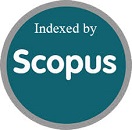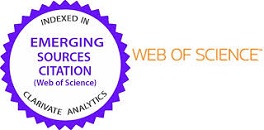Детектування амілоїдних фібрил лізоциму за допомогою триметинціанінових барвників: спектроскопічні дослідження та молекулярний докінг
Анотація
Завдяки своїм унікальним фотофізичним і фотохімічним властивостям, а також їх високій чутливості до бета-складчастих мотивів, ціанінові барвники широко застосовуються як молекулярні зонди для ідентифікації та характеризації амілоїдних фібрил in vitro та візуалізації амілоїдних включень in vivo. В даній роботі, за допомогою спектроскопічних методів та молекулярного докінгу досліджено амілоїдну специфічність та механізми взаємодії між триметинціаніновими барвниками та нативним (LzN) і фібрилярним (LzF) лізоцимом. Встановлено, що асоціація триметину з нефібрилярним і фібрилярним білком супроводжується зміною ступеня агрегації барвників. Дослідження молекулярного докінгу між триметиновими барвниками та лізоцимом у нативному та амілоїдному станах показують, що: i) триметини мають тенденцію утворювати найбільш стабільні комплекси з deep cleft of the native lysozyme; ii) зв’язування барвника з нефібрилярним білком регулюється гідрофобними взаємодіями, π-стекінгом між ароматичним або циклопентановим кільцем ціаніну та Trp у положенні 63 або 108 та водневими зв’язками між OH-групами триметинів і акцепторними атомами Asp 101 (AK3-7) і Gln 57 (AK3-8); iii) ціанінові барвники утворюють енергетично найбільш сприятливі комплекси з борозенкою Gly 2-Leu 4/Ser 8‑Trp 10 ядра фібрили лізоциму; iv) взаємодія ціаніни-LzF стабілізується гідрофобними контактами, π-стекінговою взаємодією та водневими зв’язками. Барвники АК3-7, АК3-5 та АК3-11 були обрані як найбільш перспективні амілоїдні зонди.
Завантаження
Посилання
P. Pronkin, A. Tatikolov, Molecules, 27(19), 6367 (2022). https://doi.org/10.3390/molecules27196367.
M. Bokan, G. Gellerman, L. Patsenker. Dyes Pigm., 171, 107703 (2019). https://doi.org/10.1016/j.dyepig.2019.107703.
M. Guo, P. Diao, Y.-J. Ren, F. Meng, H. Tian and S.-M. Cai, Sol. Energy Mater. Sol. Cells, 88, 33–35 (2005). https://doi.org/10.1016/j.solmat.2004.10.003.
C. Shi, J.B. Wu, D. Pan. J. Biomed. Opt. 21(5), 05901 (2022). https://doi.org/10.1117/1.JBO.21.5.050901.
G. D. Pelle, A. D. Lopez, M. S. Fiol, Int. J. Mol. Sci., 22(13), 6914, (2021). https://doi.org/10.3390/ijms22136914.
O. Cavuslar, and H. Unal, RSC Advances. 5, 22380-22389 (2015). https://doi.org/10.1039/C5RA00236B
H. L. Yang, S.Q. Fang, Y.W. Tang, et al., Eur. J. Med. Chem. 179, 736-73 (2019). http://dx.doi.org/10.1016/j.ejmech.2019.07.005.
X. Mu, F. Wu, R. Wang, Z. Huang, et al., Sens Actuators B. Chemical., 338, 29842, (2021). https://doi.org/10.1016/j.snb.2021.129842.
K.D. Volkova, V.B. Kovalska, O.A. Balanda, R.J. Vermeij, V. Subramaniam, Y.L. Slominskii, S.M. Yarmoluk, J. Biochem. Biophys. Methods, 70, 727–733, (2007). https://doi.org/10.1016/j.jbbm.2007.03.008.
V.B. Kovalska, M.Yu. Losytskyy, O.I. Tolmachev, et al., J. Fluoresc. 22, 1441–1448, (2012). https://doi.org/10.1007/s10895-012-1081-x.
J. Yan, J. Zhu, K. Zhou, et al., Chem. Commun. 53, 1441–1448, (2017). https://doi.org/10.1039/C7CC05056A.
T. Smidlehner, H. Bonnet, S. Chierici, I. Piantanida, Bioorg. Chem.,104, 104196, (2020). https://doi.org/10.1016/j.bioorg.2020.104196.
R. Sabate, J. Estelrich, Biopolymers, 72(6), 455-463, (2003).https://doi.org/10.1002/bip.10485.
G.Q. Gao, A.W. Xu, RSC Adv., 3, 21092-21098, (2013). https://doi.org/10.1039/C3RA43259A.
O. Zhytniakivska, A. Kurutos, U. Tarabara, K. Vus, V. Trusova, G. Gorbenko, N. Gadjev. And T. Deligeorgiev, J. Mol. Liq. 311, 113287 (2020), https://doi.org/10.1016/j.molliq.2020.113287
S. Chernii, Y. Gerasymchuk, M. Losytskyy, D. Szymanski, et al., PLOS One, 16(1), e0243904. (2021). https://doi.org/10.1371/journal.pone.0243904.
K. Vus, U. Tarabara, A. Kurutos, O Ryzhova, G. Gorbenko, et al., Mol Biosyst, 13(5), 1970-1980, (2017). https://doi.org/10.1039/c7mb00185a
H.L. Yang, S.Q. Fang, Y.W. Tang, et al. Eur. J. Med. Chem, 179, 736-743, (2019). https://doi.org/10.1016/j.ejmech.2019.07.005.
K. Vus, M. Girych, V. Trusova, et al. J Mol Liq, 276, 541-552 (2019). https://doi.org/10.1016/j.molliq.2018.11.149.
M. Bacalum, B. Zorila, M. Radu, Anal. Biochem., 440, 123-129, (2013). https:// doi.org/10.1016/j.ab.2013.05.031.
S. Dallakyan, and A.J. Olson, Methods Mol. Biol. 1263, 243-250 (2015), https://doi.org/10.1007/978-1-4939-2269-7_19.
S. Salentin, S. Schreiber, V.Joachim Haupt, M.F. Adasme, and M. Schroeder, Nucleic Acids Res. 43, W443-W447 (2015), https://doi.org/10.1093/nar/gkv315.
P. Csizmadia, In: Proceedings of ECSOC-3, the third international electronic conference on synthetic organic chemistry, 367-369 (1999), https://doi.org/10.3390/ECSOC-3-01775
M.D. Hanwell, D.E. Curtis, D.C. Lonie, T. Vandermeersch, E. Zurek, and G.R. Hutchison, J. Cheminform. 4, 17 (2012), https://doi.org/10.1186/1758-2946-4-17.
V. Trusova, East Eur. J. Phys. 2, 51-58 (2015), https://doi.org/10.26565/2312-4334-2015-2-06.
P.L. Donabedian, M. Evanoff, F.A. Monge, D.G. Whitten, and E.Y. Chi, ACS Omega, 2, 3192-3200 (2017), https://doi.org/10.1021/acsomega.7b00231
Авторське право (c) 2022 Ольга Житняківська, Уляна Тарабара, Атанас Курутос, Катерина Вус, Валерія Трусова, Галина Горбенко

Цю роботу ліцензовано за Міжнародня ліцензія Creative Commons Attribution 4.0.
Автори, які публікуються у цьому журналі, погоджуються з наступними умовами:
- Автори залишають за собою право на авторство своєї роботи та передають журналу право першої публікації цієї роботи на умовах ліцензії Creative Commons Attribution License, котра дозволяє іншим особам вільно розповсюджувати опубліковану роботу з обов'язковим посиланням на авторів оригінальної роботи та першу публікацію роботи у цьому журналі.
- Автори мають право укладати самостійні додаткові угоди щодо неексклюзивного розповсюдження роботи у тому вигляді, в якому вона була опублікована цим журналом (наприклад, розміщувати роботу в електронному сховищі установи або публікувати у складі монографії), за умови збереження посилання на першу публікацію роботи у цьому журналі.
- Політика журналу дозволяє і заохочує розміщення авторами в мережі Інтернет (наприклад, у сховищах установ або на особистих веб-сайтах) рукопису роботи, як до подання цього рукопису до редакції, так і під час його редакційного опрацювання, оскільки це сприяє виникненню продуктивної наукової дискусії та позитивно позначається на оперативності та динаміці цитування опублікованої роботи (див. The Effect of Open Access).








